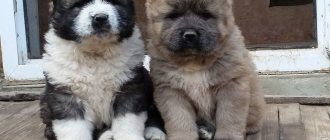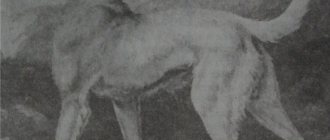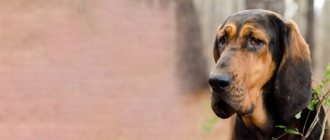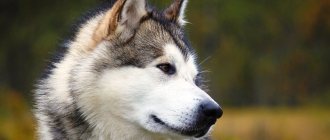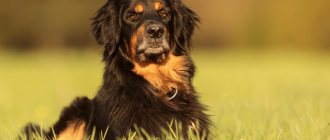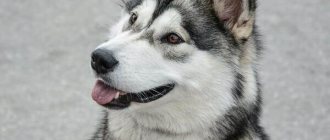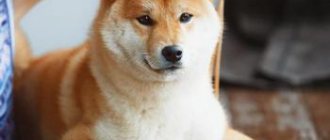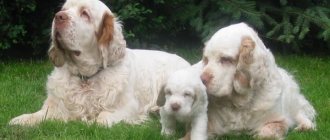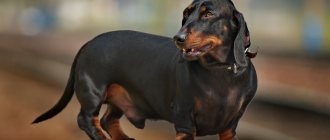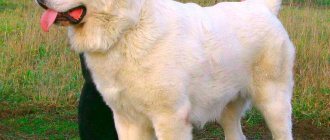Many dog lovers know that the Tibetan Mastiff is considered the most ancient breed and the progenitor of many dog breeds.
However, there is another little-known breed, which, as a result of recent research, can claim to be the oldest.
This is a Buryat-Mongolian wolfhound or Khotosho. She is poorly known among non-professionals. Let's talk about this dog, what it looks like, where it came from, whether it can be kept at home and learn other interesting facts.
Photo: wikimedia.org
Story
The first mentions of the Mongol-Buryat wolfhound are associated with tribes roaming the territory of Buryatia. Dogs served as guards and hunters. There is a version: the dogs were at Buddhist monasteries.
Dog breeders are still arguing about the origin of the breed. Many archaeologists are sure that the Khotosho Nokhoi are descendants of the oldest breed group.
Buddhists regard wolfhounds as divine creatures. Despite their impressive size, dogs were always included in the house and became the main characters of legends. One of them says: the ancestor Sarama is the right hand of God Indra, black and brown in color. The Buryat-Mongolian wolfhound is famous for this same shade, which means it is sacred. There is another belief about a black dog with reddish spots on its forehead. She put in a word in front of the angry Buddha, asking him to leave grains in the fields, and saved people from hunger and death.
At the end of the 19th century, the number of wolfhounds in Buryatia decreased by 50%. Mass breeding of dogs began. Nikolai Batov took up the task of restoring the wolfhound population.
The breed was officially registered by the Canine Society in 2000.
The dog is called:
- I want to nohoy,
- Mongolian Shepherd,
- bakharom,
- wolfhound,
- Tibet
- Mongolian mastiff,
- yard wolf.
These are not all the popular names of the animal. There are over 10 of them.
Health and life expectancy
BMWs live 12-14 years and are long-livers in their weight category. They have good health and immunity to infections. Most diseases are related to the musculoskeletal system; there are problems with the digestive system, as in all large dogs. The following common diseases are identified:
- Hip dysplasia (HJD),
- Cataracts, lens opacities,
- Intestinal volvulus.
To prevent THD, it is recommended to keep muscles toned by walking in the fresh air over rough terrain and swimming in ponds. Jumping over obstacles and running on ice are contraindicated for puppies, sick and injured dogs. Walking on loose snow develops the muscles of the chest, neck and back.
You cannot raise a puppy in a house with slippery flooring (laminate, linoleum, ceramic tiles). This affects the animal’s joints and ligaments and increases the risk of sprains.
Description
Cynologists call Mongolian wolfhounds unique individuals. The reason is the abundance of features in the dog that are alien to other breeds.
The main qualities of a wolfhound:
- independence;
- devotion to the owner, family;
- sociability;
- friendliness;
- playfulness;
- learning ability;
- protection;
- ability to swim well.
The Buryat is able to adapt to any situation and the different moods of the owner. A calm environment around is important for the dog.
| Body part | Peculiarities |
| Head | Beautifully shaped, with strong skull and cheekbones |
| Neck | Strong. Equal in proportions to the muzzle |
| Rib cage | Wide, round |
| Lips | Full |
| Nose | Big, black |
| Teeth | Densely arranged, large, white. Scissor bite |
| Eyes | Oval, medium. Shade from amber to brown |
| Back | Wide, with well-developed muscles |
| Ears | Medium in size, triangular in shape. In a calm mood they hang, in a wary mood they rise |
| Leather | Dense, elastic |
| Paws | Straight, strong, neat |
| Tail | In a balanced state, lowered. Rising with emotional outburst |
| Wool | Dense, rough. The undercoat is thick and soft |
Description
The standard positions the Bankhara as a guard, guard and security dog. These animals are used as bodyguards and simply companions, and are also taken with them on hunts. They are used in various emergency situations, for searching for missing people, and even in law enforcement service.
Appearance
Khotosho is a very large, athletic, powerful animal of rough constitution with heavy massive bones and well-developed prominent muscles. The body is of a slightly elongated rectangular format with a rounded, deep, widened sternum, a straight, strong back, clearly visible withers, a somewhat convex, not too long loin and a moderately tucked belly. Sexual dimorphism is clear, females are much smaller and lighter than males.
Bankhar has a very large, powerful and massive physique
Breed standard:
- Height at withers: females - from 66 cm;
- males - from 74 cm.
The wolfhound moves in a measured, leisurely manner, sweepingly and freely. The jumping trot is considered the characteristic and preferred gait, and when accelerated it turns into a gallop. All movements are elastic and springy, while the topline remains straight.
The coat is thick, straight, hard and rough to the touch with a densely packed soft undercoat. Shorter and tighter hair on the head and front of the legs.
The standard distinguishes three types according to coat length:
- Short-haired. The dog's body is evenly covered with short and very thick hair with dense, well-developed down. During the cold season, the undercoat grows longer than the main hair.
- Long-haired. The guard hair is of considerable length. The long coat forms trousers (feathers) on the limbs and a characteristic mane on the neck. The tail is covered with elongated hair on all sides.
- Intermediate. The outer coat is of medium length. On the tail there is a dewlap of elongated hair (on the lower part), a slight and not very pronounced, beautiful coat (mane and trousers).
The hotosho coat, the main protection against external influences, copes with this task perfectly, protecting the dog from any precipitation: from rain to snow. In addition, the correct coat has a tendency to self-clean - foreign impurities from thorns to clay easily slide off it.
Another feature is the tendency to intense seasonal shedding, when even a long-haired dog looks short-haired if you do not pay attention to the dewlap on the tail.
Extract from the standard
The following colors are allowed:
- black and tan (basic) with very light, almost white to copper markings;
- zoned-tan;
- red (from rich and bright fiery red to diluted fawn);
- black.
White spots on the chest, tail (tassel), and lower legs are acceptable.
In the warm season, during molting, the wool from the bankhar comes off in layers
Disadvantages and disqualifying vices
Minor defects or deficiencies are considered:
- height deviations: females - up to 64 cm;
- males - up to 72 cm.
The following are recognized as defects or serious deficiencies:
- small stature: females - less than 64 cm;
- males - less than 72 cm.
The reasons for disqualification will be:
- color spotted or piebald;
- cryptorchidism;
- overshot, undershot, absence of incisors, premolars (except the first), canines, molars (first and second);
- Blue eyes;
- ambling movements (unilateral rearrangement of limbs).
Character and psyche of the breed
Despite its impressive dimensions, Khotosho has a cheerful and cheerful, pronounced sanguine temperament . He is mobile, easy-going, full of energy and permanently self-confident. The dog is curious, always carefully watching everything and everyone. This quality makes him an excellent guard, reliably guarding the territory and property entrusted to him. He perceives strangers with caution and distrust, but does not show any aggression until he sees a real danger emanating from them. In this case, he is able to make independent decisions and act decisively.
Khotosho is always on the alert and vigilantly guards the territory entrusted to him
The Tibetan wolfhound is peace-loving and very balanced; in principle, he is not inclined to enter into conflict situations, trying to the last to simply scare the enemy . But if necessary, he is quite capable of defending his honor. He gets along well with all pets, seeing them as a ward flock in need of protection and care. Banhar becomes strongly attached to all family members, showing boundless devotion. He treats children of all ages very carefully, allowing and forgiving them many pranks.
Since ancient times, Buryat-Mongolian wolfhounds have played the role of nannies for the master's children, who were quietly left in the care of the dogs. The huge animal did not allow the children to stray far from home, standing in the way and gently pushing them with its body in the right direction. There have been many cases on the water when they wanted to control swimming human offspring, not giving them the opportunity to swim beyond a certain safe border.
Behavior and skills
The Buryat dog breed is distinguished by its balance. Dogs do not attack without a reason; they quickly think through every action. Dogs show aggression when they really cannot do without it, protecting their owner. Wolfhounds often save unfamiliar children from harm.
Mongolian Shepherds are attentive to every assignment and carry out commands of any complexity. Dogs benefit from a high level of intelligence.
There are also disadvantages in the behavior of wolfhounds. Dogs are subject to frequent mood swings. This negatively affects the dog’s sociability, obedience, and desire to follow commands.
Wolfhounds are distinguished by their strong-willed disposition. Dogs build relationships with people as cooperation. They do not accept unquestioning submission.
Expert opinion
Anna Abramenko
An avid dog lover. Experience in veterinary medicine since 2009.
Ask a Question
The wolfhound is easy to train. A properly raised dog demonstrates important skills from childhood. The dog is clean, while locked up, will not allow himself to relieve himself in the house, and will show patience.
A wolfhound can be the best nanny. The dog will look after the children in the yard and bring them back from their walks in a timely manner.
The dog does not ignore calls for help. Having noticed a drowning person, the wolfhound will begin to bark, draw attention to the incident, rush into the water, and save the victim.
The breed is also a godsend for unhealthy people. Buryat-Mongols are ready to bring the necessary thing, warm the owner with their bodies, and after training, become guides for the visually impaired.
Training
City BMWs must complete a general obedience course (GOC). The breed is late in maturity; lovers of service dogs (German and East European shepherds, Giant Schnauzers, etc.) find Mongolian aborigines slow and disobedient. In refutation, breeders point to the peculiarities of the nervous system of their pets.
BMW tends to make decisions independently , which is due to its origin and centuries-old traditions of being kept by nomads. It is important to establish contact with the dog, to become its leader in order to achieve unquestioning obedience coupled with trust.
When undergoing training for guard and protective service, Khotosho show excellent results. Legislation equates a dog with such skills and size to a weapon, therefore, before training, the stability of the dog’s psyche and the ability to control the pet are checked.
Character and appearance
Dogs are often called yard wolves. Wolfhounds are confident, decisive, and strongly attached to home. There are dogs from foreign and native territory. The dog will never start a conflict. If there are several animals, he will not offend the weak or provoke his own kind.
The wolfhound respects those around him, but will not tolerate shouting or rude actions. The dog will not respond to cruelty with aggression, but will achieve its goal by completely ignoring the owner. If household members are fair to the animal, then there will be no problems.
The only people to whom the wolfhound will not show character are children. The dog will tolerate pampering and attempts to ride him. Having noticed a child playing deep in the river or sea, the dog will push him to the shore.
The Mongol-Buryat wolfhound is one of the most massive dogs of our time. Males reach 75 cm. The height of females is 65 cm. The average weight of a mature individual is 75 kg.
The dog's body and head are large, the muzzle does not look bulky. Oval eyes of brown color (there are yellowish-amber shades). The dog's chest is deep-set. The dog has strong, sinewy legs. The wolfhound's muscles are hidden by fur. Among representatives of the breed, it is long or short, but always thick, repelling moisture. Hotosho come in black, tan, and reddish colors.
Expert opinion
Anna Abramenko
An avid dog lover. Experience in veterinary medicine since 2009.
Ask a Question
In summer, dogs shed, and by winter a dense undercoat appears. The dog survives any season comfortably.
Characteristics and breed standard
Height at withers: males – 74 cm and above, females – 66 cm and above.
Weight: not included in the standard.
Color: black with red tan. Zoned gray color, solid brown and red coat color are allowed. There may be small white spots in the area of the chest, tip of the tail and all limbs with an even distribution.
Eye color: brown and its variations.
Nose color: not included in the standard.
General appearance: a massive dog with a strong build, coat of any length, but a thick undercoat. Volumetric head and wide muzzle, drooping ears. Movements are free.
Breeding
The roots of the breed go back to ancient times, but the wolfhound cannot be called a common species. Such dogs are often found in Buryatia, Tibet, and in the cities of Central Asia.
The breed is bred by private dog breeders and nursery specialists. To develop the livestock, healthy individuals with the best physical and psychological characteristics are recruited.
Expert opinion
Anna Abramenko
An avid dog lover. Experience in veterinary medicine since 2009.
Ask a Question
The first dogs that come across will not make a couple. Domestic wolves are selective in choosing a partner. It will take time to get to know each other and develop sympathy in dogs.
Education and training
Wolfhounds can be trained from 2 months of age. Dogs are already receptive to commands and understand what is expected of them. When it comes to raising and training a dog, it is important to adhere to humane methods. Otherwise, a frightened, cowardly dog will grow up.
It is worth starting the training process for a wolfhound with basic tasks, gradually complicating them.
Teams:
- "Near". The ability to accompany the owner is an important skill. Having found it, walking with your dog will turn into pleasure. The pet will walk close to the person’s leg and run away only after receiving permission. When saying the word “near”, you need to jerk the leash. When the dog tries to run away from the owner, the manipulation must be repeated.
- “Fu” is pronounced in a firm tone. The puppy should feel the person’s irritation.
- "Sit". With such a command, they place their palm close to the dog’s muzzle.
- "Lie". First, after indicating the request, you will have to guide your four-legged friend and help him lie down. Over time, the dog must cope with the goal on its own.
- "To me". If the puppy immediately runs after hearing the task, he should be rewarded with a treat.
- "Aport." One of the favorite teams of pets, accepted for the game.
Every correct action of a four-legged animal should be encouraged. You can't skimp on praise. It is important for the dog to feel that the owner is happy and sees progress in the animal’s actions.
There is no need to delay the training process. If the dog gets tired, then next time he will be reluctant to make contact.
Price and where to buy a puppy
An animal with excellent working qualities, which is the bankhar, is quite expensive. The cost of a puppy varies from 65,000 to 150,000 rubles. Such a high price is due to the low prevalence of the breed. But she is increasingly winning the hearts of dog breeders in Russia.
You need to be careful when buying a puppy. This should only be done in a specialized nursery. On the market you can find representatives of the breed that are much cheaper, but such a huge dog with an unstable psyche, bred outside a breeding kennel, can cause harm to its owner.
When buying a puppy of this breed, the owner is faced with an unexpected question - a nickname . After all, it’s quite difficult to come up with a name for such a thug, even with a calm temperament. In addition, the nickname that can be given to a fluffy, clumsy bear cub may not be at all suitable for the formidable guard that he will soon become.
What nicknames can you suggest? These are unlikely to be simple names such as Sharik or Druzhok. Fashionable ones - Amethyst, Baron - will not work either. The name of such a dog should reflect its ancient origins and sound serious. For example: Chingiz, Zavgar, Terra, Elba, Khatis, Hadisa, Khan, Hannah, Sheik and others.
In any case, the choice of nickname is up to the owner; often the name “comes” after the first meeting with a friend.
A killing machine growing? #hotosho #wolfhound pic.twitter.com/Z67rpVjPd5
— Photo from Ulan-Ude (@InstaUlanUde) March 19, 2016
Care and maintenance of the Buryat-Mongolian wolfhound
Dogs are not whimsical. Keeping wolfhounds at home or in the yard is not a labor-intensive task.
If a Buryat-Mongolian dog lives on the street, then it is necessary to provide a spacious booth or enclosure. It is important that there is no draft and that there is shade.
What should a pet owner do:
- Comb, cut out tangles.
- Trim nails monthly.
- Check paw pads after every walk. If cuts are found, treat promptly.
- Rinse the dog's eyes with the broth.
- Brush your teeth with a special paste.
- Follow the vaccination schedule. Vaccinations starting at 1 month of age.
- Bathe your furry friend as soon as he gets dirty. The dog is capable of self-cleaning. It is enough to arrange water treatments 2-3 times a year in the summer. Any dog shampoo will do.
Nutrition
Wolfhounds are not capricious, but it is important to be careful about feeding. Food should be balanced and healthy. The dog will need additional vitamins.
The main products for maintaining the tone and strength of the breed:
- lean meat;
- heart, liver;
- boiled cereals;
- cottage cheese, kefir, fermented baked milk;
- seafood;
- chicken, quail eggs;
- vitamin preparations.
Representatives of the breed love to eat; allergic reactions to food do not occur.
In the first 3 months, puppies eat up to 6 times a day. From six months - three times. From 12 months eat twice a day.
Expert opinion
Anna Abramenko
An avid dog lover. Experience in veterinary medicine since 2009.
Ask a Question
Breeders of the breed recommend dry food. Cheap options for dogs are not suitable. The health and well-being of your pet depends on food.
It is recommended to feed the animal 2 hours before or after activity.
Feeding
The breed is very unpretentious in nutrition. You can feed both natural products and prepared foods. Interestingly, most breeders of the breed choose natural nutrition.
Rules for creating a natural diet:
- The share of meat products is 2/3 of the daily diet;
- Choose lean meat: beef, turkey, chicken, offal;
- Cereals are mixed with the meat;
- The diet includes boiled sea fish;
- Sour milk - low fat content;
- Vegetables can be anything. The exception is tomatoes;
- You can give a raw egg twice a week.
It is necessary to strictly monitor the serving size. In addition, you need to follow the feeding rule regarding the walk: an hour and a half before the walk and no earlier than an hour and a half after it. Otherwise, the dog may be at risk of gastric volvulus and will require surgical intervention.
As for ready-made dry food, there are special requirements for it: the food must be premium class, designed for large dogs, and preference should be given to holistic food.
Photo: ytimg.com
Pros and cons of a wolfhound
Dog breeders respect dogs of this breed for many advantages.
Advantages:
- kindness;
- stress resistance;
- devotion;
- intelligence;
- energy;
- unpretentiousness;
- courage;
- attentiveness to children and the elderly.
Cons are much more difficult to find.
Disadvantages: massive, difficult to keep in a small apartment.
Interesting facts from the life of dogs
According to the description of the breed, Khotosho is ready to sacrifice himself for the sake of a person. There are many cases where a dog died, pulling its owners, strangers, or animals out of water or fire.
The wolfhound will not think about himself when his loved ones need help. The dog will instantly rush to the person.
Domestic wolves respect and value their owner, but are proud and often demand recognition.
Reviews
Maria Klyuchnevskaya: “I have 2 Mongol-Buryat wolfhounds. Dogs can be trained instantly. They carry out commands confidently after several days of training.”
Sergey Lasnik: “I like energy, kindness, openness and good health in the Buryats. There are rarely any problems with a wolfhound. The dog will not get into a fight and will not become a source of negativity. A dog shows aggression in extreme cases, when the owner is in real danger.”
Anatoly Kolesnichenko: “For me, the Buryat wolfhound is the best breed. The dog completely replaces the nanny. Looks after children, plays with them during walks, and correctly protects them from attacks from peers. This is not just an animal, but a member of the family.”
Who should start a hobby?
BMWs are not suitable for beginners in cynology, with rare exceptions. Do not become a full owner of a child either. They require an individual approach to education. Wolfhounds get along best with people who know how to show authority.
These dogs are not suitable for athletes . It is important for BMWs to be useful, so it is advisable to set them on security. In addition, the natural talents of a watchman will manifest themselves with age.
Wolfhounds mature late; physical development, along with psychological development, ends after 3 years. They should not be expected to perform productive work until they reach the specified age.
In the city, such a pet will feel good if it is provided with long walks at a leisurely pace and properly socialized. He treats family members without aggression and behaves carefully with children. He recognizes other domestic animals as the property of the owner and considers it his duty to protect them from danger.
Photo and video review
The Buryat-Mongolian wolfhound is one of the oldest breeds. Dogs have unique abilities and external characteristics. This is clearly visible in photos and videos.
